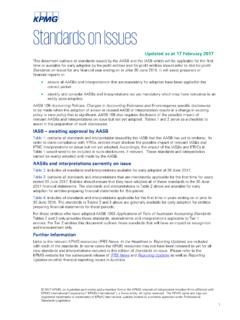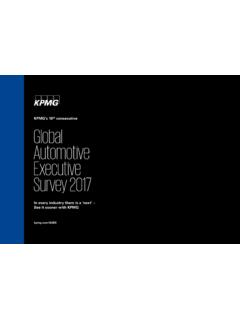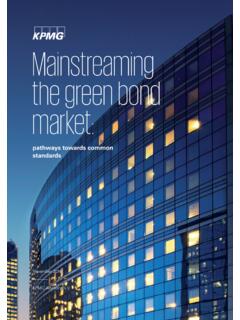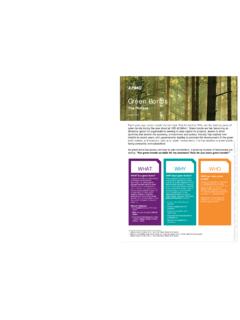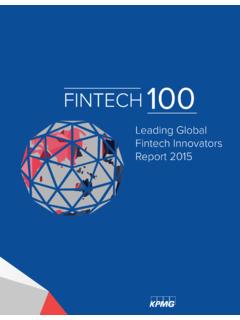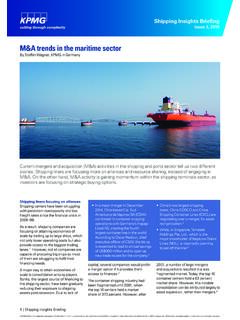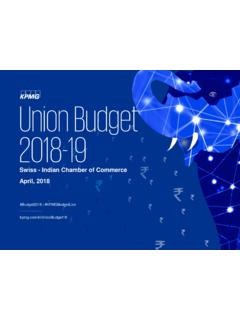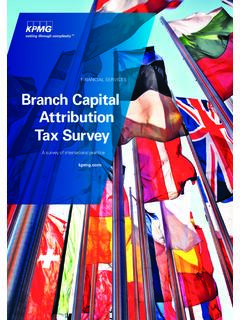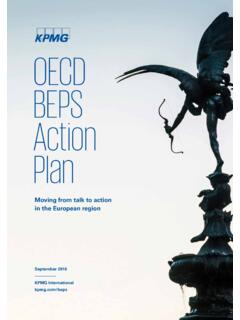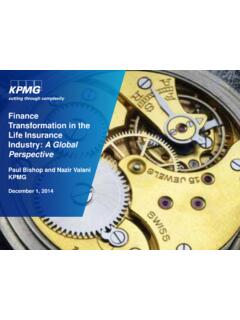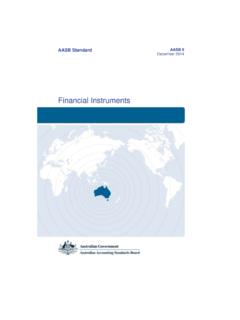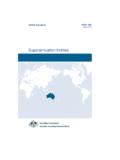Transcription of AASB 16 Leases - KPMG | US
1 aasb 16 fundamental overhaul of lessee accounting effective 2019 2017 KPMG, an Australian partnership and a member firm of the KPMG network of independent member firms affiliated with KPMG International Cooperative ( KPMG International ), a Swiss entity. All rights reserved. The KPMG name and logo and are registered trademarks or trademarks of KPMG International. Liability limited by a scheme approved under Professional standards Legislation. A new leasing standard aasb 16 Leases removes the concept of operating and finance Leases for lessees which exists under aasb 117 Leases , replacing it with a single accounting model under which lessees must recognise all Leases (including property and equipment) on the balance sheet as a new right of use asset and lease liability . Small value assets and short term Leases are excluded. The rules for lessors have not significantly changed. The change to bring the majority of Leases on balance sheet was driven by the IASB to improve transparency, comparability and disclosure of companies leasing activities.
2 What is the impact of the new standard?The changes in accounting are not limited to the balance sheet. For example, the lease expense profile will be front-loaded for most Leases , even when rental payments are constant year-to-year. New information will also be required to support the determination of new judgments and estimates used in the calculation of the leased asset and liability on inception date and throughout the lease . These include lease term, discount rates, in-substance lease payments, rents linked to a rate or index, expected payments under residual value guarantees and inclusion of purchase options and termination the economic benefits and risks of leasing does not change, the new lease accounting model will change key financial metrics and KPIs and introduce volatility to the balance sheet and profit or loss due to continual re-measurement requirements. As such, careful communication of this impact to key stakeholders such as investors, banks and credit rating agencies will be to aasb 16On transition to aasb 16 an entity will have a number of interdependent options and practical expedients available.
3 The different transition options will result in a different impact on transition and subsequently to the balance sheet and profit or loss. We therefore recommend companies model the various transition option results to their balance sheet and profit or loss going forward to assist in the determination of the most optimal transition impactsAs well as financial reporting changes, aasb 16 also has business-wide impacts, including, but not limited to, modifications and management of: New leasing systems to capture data and perform calculations; Debt covenants and credit rating, given new debt on balance sheet; Impairment tests and tax effect accounting, given increase in assets and liabilities; and Opex, capex approval processes and buy vs. lease impacts should be managed and carefully communicated to stakeholders at both the transition date and on an ongoing with operating Leases will a ppear to be more a sset-r ich, but also more h eavily indebted Impact on lessee balance sheetDepreciationInterestCash rental paymentsTotal lease expense will be front-loaded even when cash rentals are c onstant Impact on lessee profit or lossAssetLiabilityCompanies with operating Leases will a ppear to be more a sset-r ich, but also more h eavily indebted Impact on lessee balance sheetDepreciationInterestCash rental paymentsTotal lease expense will be front-loaded even when cash rentals are c onstant Impact on lessee profit or lossUnderstanding the impact to your companyExpected impact to KPIs / ratiosCompanies will see an increase in their EBIT / EBITDA profitability and ratios given the lease expense will be reported below the line.
4 An increase in leverage ratios will reflect additional debt on the balance sheet from the lease with operating Leases will appear to be more asset-rich, but also more heavily lease expense will be front-loaded even when cash rentals are or lossBalance sheetRatiosEBITDAT otal asset Total liabilitiesGearingEPS (in early years)Net assets(in early years)Asset turnover 2017 KPMG, an Australian partnership and a member firm of the KPMG network of independent member firms affiliated with KPMG International Cooperative ( KPMG International ), a Swiss entity. All rights reserved. The KPMG name and logo and are registered trademarks or trademarks of KPMG International. Liability limited by a scheme approved under Professional standards Legislation. What are your next steps?One of the biggest hurdles your organisation may face is obtaining an understanding of your lease portfolio characteristics and setting up new systems, processes and controls to manage your lease portfolio going forward.
5 Organisations should not under-estimate the time required to collect lease data and assess the impact of the new standard. Below are suggested steps to ensure a successful transition to the new lease accounting your project team Who is leading and supporting your implementation project? Which business areas should be involved? Are there any training requirements to raise awareness?1 Understand your lease portfolio How many Leases do you have? Where is your lease information stored? Do you have all the data required to calculate a right of use asset and a lease liability? Could there be any embedded Leases in service contracts? What new Leases will you sign by 2019? Where are accounting judgments and assumptions required?2 Investigate structural solutions to reduce impact Which terms can you negotiate to reduce your lease liability or eliminate volatility? Can alternative off balance sheet arrangements be structured?3 KPMG provides a range of services and solutions that can help your organisation successfully implement aasb 16, please see next page to understand how we can assist assessment of current systems, processes & controls Which processes and controls for affected business units will need to be modified or established?
6 Can your existing systems cater for the new data and measurement requirements or will a new system be required? Which accounting policies will you need to update?5 Determine future state design How will you implement, test and embed new systems, processes and controls? What are your timing, cost and resource restraints?6 Implementation Will your company be set up to meet the requirements of aasb 16 by 2019? Can you deliver on your implementation plan?7 Select transition option Which transition method will you apply? Do you have all the data to be able to apply the full retrospective approach? Will you apply any optional exemptions? What will you say about aasb 16 in your 2017 annual report?42015 & prior20182019202 0 & beyond20172016 Effective Date: 1 Jan. 2019 aasb 16 issued Jan. 2016 Comparative start: 1 Jan. 2018 (if full retrospective option is chosen)Disclose impact in annual finance statements: 31 Dec. 2017 Implementation timelineHow KPMG can help with your implementation projectSome or all of the services described herein may not be permissible for KPMG audit clients and their or support your implementation project Provide our global tools and methodologies to support your project needs, including experienced project managers with proven methodologies and tools to assist you with gap analysis, transition option modelling, impact assessment for key financial metrics, analysis of changes required to processes and systems and project management advice Support the finance team with analysis of complex contracts and provide assistance with key judgments and assumptions.
7 Develop solutions to minimise the impact of the new impact assessment KPMG Impact Analysis Tool can help you determine the most appropriate transition option by quantifying the impacts to the balance sheet profit, or loss and key metrics under the different transition options to assist you with communicating the change to key stakeholders. Perform systems assessment, strategy, design, configuration and implementation & IT system change solutionsKPMG Leasing Tool for IBM TRIRIGA KPMG has worked with IBM to develop KPMG Leasing Tool for IBM TRIRIGA , a cloud- based , pre-packaged KPMG solution that enables clients to centralise data and meet the new accounting requirements on a go forward basis, for both aasb 16 and US GAAP ASC strategy & valuation services Support the company to determine the optimal procurement strategy and lease terms. Provide valuation services of KPMG s SGA and Real Estate Advisory Services usMichelle GibbsNational Leasing Lead Sydney +61 2 9455 9028 BertaPerth+61 8 9263 7556 PrattBrisbane+61 7 3233 9775 KlunderMelbourne+61 3 9838 4703 information contained in this document is of a general nature and is not intended to address the objectives, financial situation or needs of any particular individual or entity.
8 It is provided for information purposes only and does not constitute, nor should it be regarded in any manner whatsoever, as advice and is not intended to influence a person in making a decision, including, if applicable, in relation to any financial product or an interest in a financial product. Although we endeavour to provide accurate and timely information, there can be no guarantee that such information is accurate as of the date it is received or that it will continue to be accurate in the future. No one should act on such information without appropriate professional advice after a thorough examination of the particular the extent permissible by law, KPMG and its associated entities shall not be liable for any errors, omissions, defects or misrepresentations in the information or for any loss or damage suffered by persons who use or rely on such information (including for reasons of negligence, negligent misstatement or otherwise). 2017 KPMG, an Australian partnership and a member firm of the KPMG network of independent member firms affiliated with KPMG International Cooperative ( KPMG International ), a Swiss entity.
9 All rights reserved. The KPMG name and logo and are registered trademarks or trademarks of KPMG International. Liability limited by a scheme approved under Professional standards Legislation. March 2017. 2017 KPMG, an Australian partnership and a member firm of the KPMG network of independent member firms affiliated with KPMG International Cooperative ( KPMG International ), a Swiss entity. All rights reserved. The KPMG name and logo and are registered trademarks or trademarks of KPMG International. Liability limited by a scheme approved under Professional standards Legislation. Which Leases come onto balance sheetAASB 16 replaces aasb 117 and IFRIC 4 when determining whether a contract contains a lease . A reassessment of contracts to determine if lease arrangements exist under aasb 16 will be required unless the practical expedient not to reassess all contracts is applied. Many companies will also need to carefully assess whether there are Leases embedded within other types of service contracts.
10 For example, this may be the case when the entity is the only party using the asset. A lease arrangement exists if:Companies may apply the practical expedients not to recognise an asset and liability for leased assets less than approximately USD $5,000 or with lease terms (including options to extend) of 12 months or change to balance sheet and P&L profileFrom 1 January 2019 all lessees will recognise a right-of-use (ROU) asset and a corresponding lease liability for all Leases . An example illustration is as follows:Identified assetThere is an identified asset explicitly or implicitly in a contract when the supplier does not have a substantive right to substitute the asset and the asset is physically over useControl exists when the customer has the right to obtain substantially all the economic benefits from the use of the asset and direct how and for what purpose the asset is +=Balance SheetPP&EROU assetOtherTotal assetsToday44,250-35,25679,506 aasb 1644,2503,28035,25682,786 BorrowingsLease liabilityTotal liabilities22,567-22,56722,5673,38725,95 4 Net assets56,93956,832 Profit or lossRevenueToday10,000 aasb 1610,000 Expenses:Operating leaseOtherEBITDA(1,000)(110)8,890-(110)9 ,890 AmortisationInterestNet profit/loss--8,890(820)(287)8,783 Transition optionsWhen applying the new standard, your company can adopt one of the following transition options.
